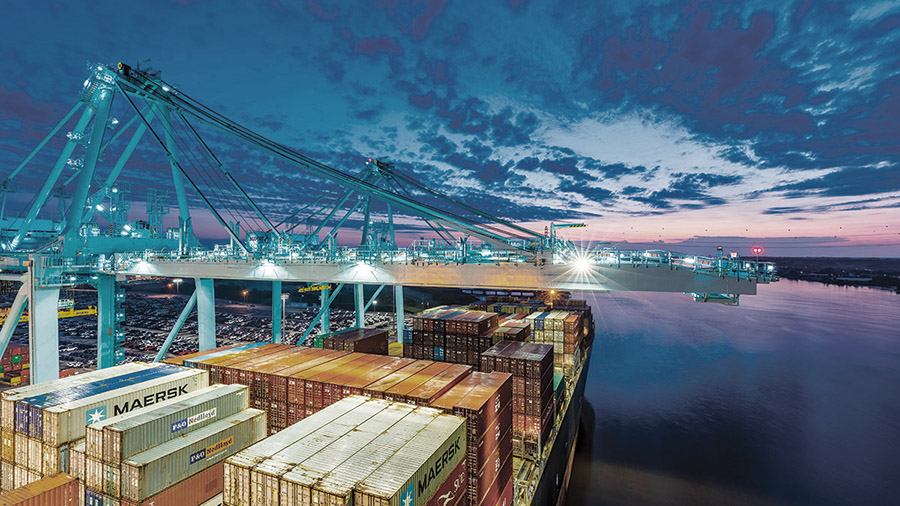The National Retail Federation (NRF) is suggesting that monthly inbound cargo volume at the nation’s major container ports could see a near-record surge in August as retailers bring in merchandise ahead of a potential strike at East Coast and Gulf Coast ports this fall, according to the Global Port Tracker report released on August 8 by the National Retail Federation (NRF) and Hackett Associates.
“Retailers are concerned by the possibility of a strike at ports on the East and Gulf coasts because contract talks have stalled,” said NRF Vice President for Supply Chain and Customs Policy Jonathan Gold. “Many retailers have taken precautions, including shipping earlier and shifting cargo to West Coast ports. We hope to see both sides resolve this issue before the current contract expires because retailers and the economy cannot afford to see a prolonged strike. This comes on top of ongoing disruption issues, including the attacks on commercial vessels in the Red Sea. Vessel diversions have led to increased shipping times and costs and have led to equipment shortages and congestion in Asian ports.”
The contract between the International Longshoremen’s Association (ILA) and the U.S. Maritime Alliance covering East Coast and Gulf Coast ports will expire on September 30. Negotiations have broken down, and the ILA has threatened to strike if a new contract is not reached by then.
Rising freight rates have also prompted importers to ship earlier.
“Importers are continuing to grow their inventories and are shifting cargo to the West Coast as a precaution against potential labor disruptions,” Hackett Associates Founder Ben Hackett said. “We calculate that the shift has pushed the West Coast share of cargo we track to above 50 percent for the first time in over three years.”
![]() U.S. ports covered by Global Port Tracker handled 2.16 million Twenty-Foot Equivalent Units (one 20-foot container or its equivalent) in June, the latest month for which final numbers are available. This is up 3.6 percent from May and 17.7 percent year-over-year, bringing the total for the first half of 2024 to 12.1 million TEU, up 15 percent over the same period in 2023.
U.S. ports covered by Global Port Tracker handled 2.16 million Twenty-Foot Equivalent Units (one 20-foot container or its equivalent) in June, the latest month for which final numbers are available. This is up 3.6 percent from May and 17.7 percent year-over-year, bringing the total for the first half of 2024 to 12.1 million TEU, up 15 percent over the same period in 2023.
The totals include estimates for New York/New Jersey and Miami ports. They still need to report June TEU counts.
Ports have not reported July’s numbers, but Global Port Tracker projected that volume increased to 2.34 million TEU, up 22.1 percent year-over-year, the highest level since the record of 2.4 million TEU set in May 2022.
August is forecasted to total 2.34 million TEU, up 19.2 percent year-over-year. September is forecasted at 2.16 million TEU, up 6.5 percent year-over-year; October at 2.09 million TEU, up 1.7 percent; November at 1.98 million TEU, up 4.4 percent; and December at 1.94 million TEU, up 3.5 percent. Those numbers would bring 2024 to 24.9 million TEU, up 12.1 percent from 2023.
The import numbers come as the NRF forecasted 2024 retail sales, excluding automobile dealers, gas stations, and restaurants, to focus on core retail, which would grow between 2.5 percent and 3.5 percent over 2023.
Global Port Tracker, produced for the NRF by Hackett Associates, provides historical data and forecasts for the U.S. Ports of Los Angeles/Long Beach, Oakland, Seattle, and Tacoma on the West Coast; New York/New Jersey, Port of Virginia, Charleston, Savannah, Port Everglades, Miami, and Jacksonville on the East Coast, and Houston on the Gulf Coast.
The NRF analyzes industry economic conditions through reports, including the Global Port Tracker. To learn more, go here.
Image courtesy Port of Jacksonville















